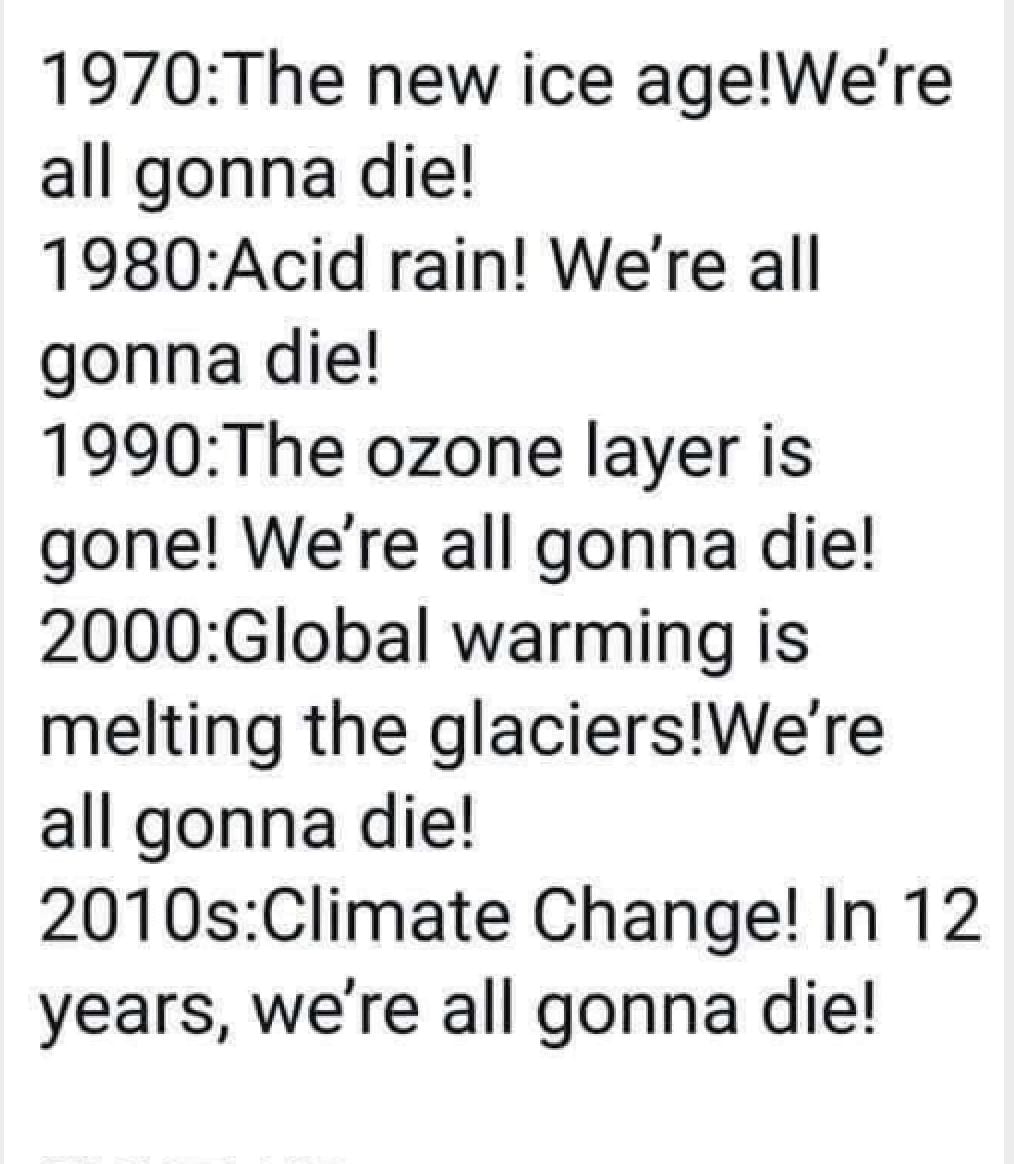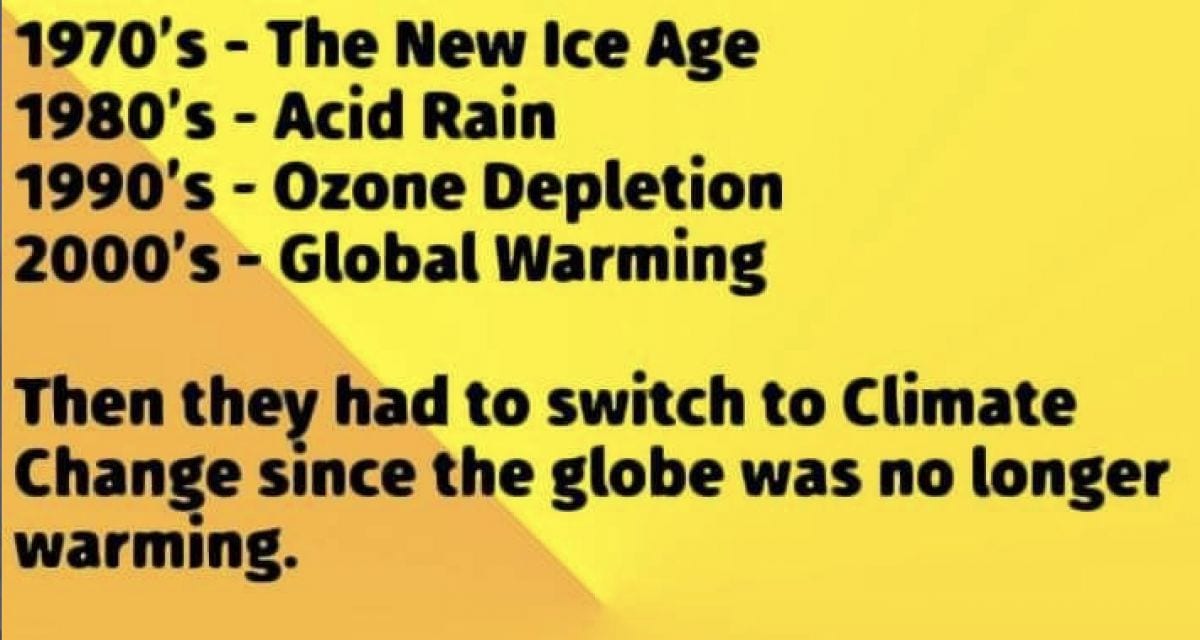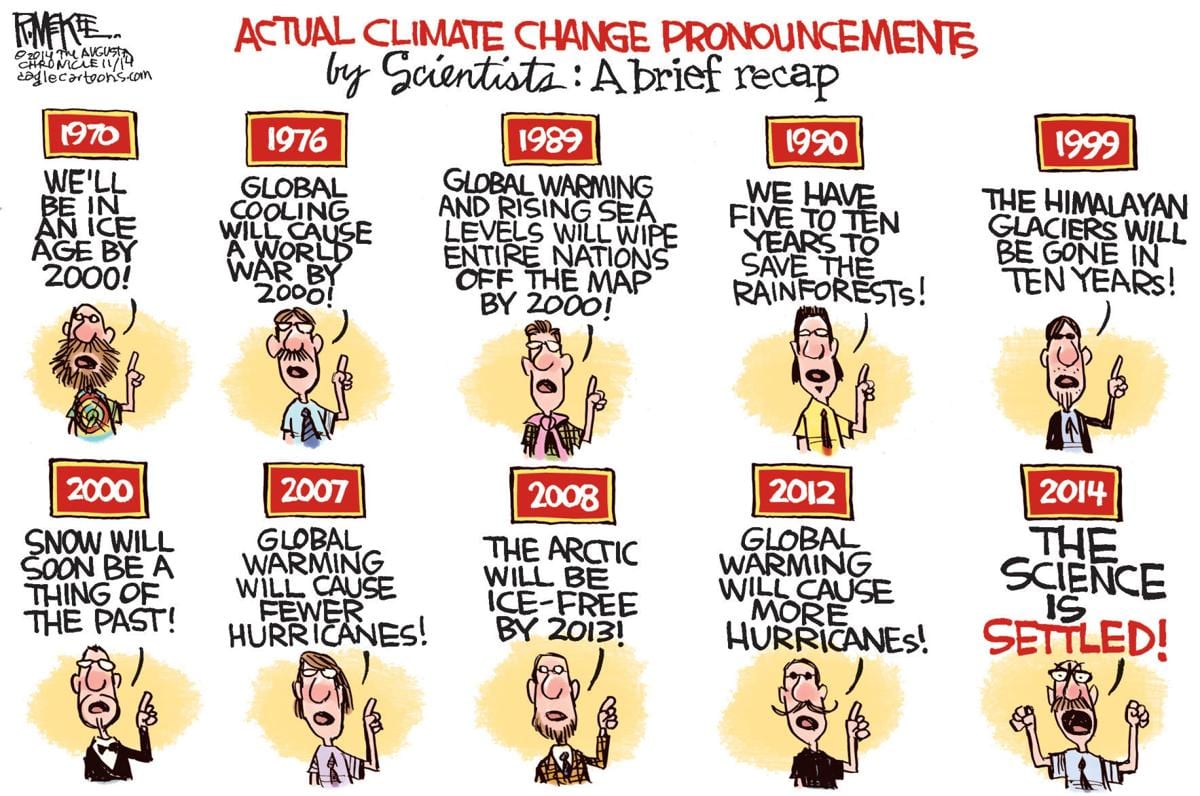This was really something.
Of course I do not watch MSNBC and definitely not this show, but someone showed me this clip and I had to share it with you.
Before we get into the headline, I have to first comment on what she said before getting there.
When asked about “Climate change” she said this:
“What scares me is every time you go back to the scientists, they tell you two things,” the senator said. “It’s worse than we thought, and we have less time.
Here’s what I find absurd about that.
I actually find it’s the opposite of that in my experience!
Sure, the rhetoric is getting amped up.
Sure, they’re trying to make it SEEM like it’s an emergency.
But in reality?
The facts?
Here’s what I’ve experienced in my lifetime and I’d like to know what happened to these:
Weren’t they all a crisis that was going to end the world in 10 years if we didn’t do something?
Did they all just go away on their own?
And this:
Hmmm……
Ok, sorry for that detour but I couldn't let her statement go without giving you what I have EXPERIENCED in just my lifetime.
Now, here's her solution.
No new houses!
When you watch the clip, she actually says that and then stumbles back to say "unless carbon neutral."
It's very awkward.
Watch:
My friends over at the Western Journal had more:
Warren then moved on to her plan for housing, which she said was borne out of the dire predictions scientists have been making.
“What scares me is every time you go back to the scientists, they tell you two things,” the senator said. “It’s worse than we thought, and we have less time.
“That means we’ve got to be willing to do things, for example, like regulation. By 2028, no new buildings, no new houses, without a zero carbon footprint.”
And she’s coming for your car and electricity bill, too.
“By 2030, trucks — light-duty trucks and cars, zero carbon footprint. By 2035, all production of electricity, zero carbon footprint,” Warren said.
“We do three regulations, we can cut our carbon footprint by 70 percent,” she said.
Oh, and there was also talk of some vague idea of social justice — because schemes like this always need to be undergirded with some such vague idea.
Advertisement - story continues below
“We also need to make environmental justice really at the heart of our climate plan,” Warren said.
“A central part of the plan for me is I want to put a trillion dollars into cleaning up the places that collectively we have destroyed as a nation and bringing them back,” she said.
Just out of morbid curiosity, I looked at the section of Warren’s campaign websitedealing with environmental justice and then rather wished I hadn’t.
Completing this poll entitles you to The Western Journal news updates free of charge. You may opt out at anytime. You also agree to our Privacy Policy and Terms of Use.
“We didn’t get here by accident. Our crisis of environmental injustice is the result of decades of discrimination and environmental racism compounding in communities that have been overlooked for too long,” Warren says on the site.
“It is the result of multiple choices that put corporate profits before people, while our government looked the other way. It is unacceptable, and it must change.”
Warren advocates a “just transition” for all Americans via her flavor of the Green New Deal, which should be interesting when the economically vulnerable and marginalized individuals she claims to care so much about see the price of an electric car or a carbon-neutral home.
That’s going to be especially true when you consider that the only reasonably cheap option for green energy is nuclear, and Elizabeth Warren will be having none of that.
“We’re not going to build any nuclear power plants and we’re going to start weaning ourselves off nuclear energy and replacing it with renewable fuels,” she said during CNN’s mammoth climate town hall back in September.
I wonder how much of Warren’s bluster on the environment is naïveté and how much of it is cynicism.
On the naïve side, this isn’t affordable or practical. It would lead to a mass voter revolt once the bills started coming due.
On the other hand, there’s also the element of cynicism. This has no chance of happening on the timetable Warren is proposing — certainly not with congressional approval, given that there are even some Democrats who would blanch at such an obviously self-defeating suite of environmental laws.
However, when you consider how serious of a candidate Elizabeth Warren is, consider that this is a woman who wants to ban regular old buildings in favor of carbon-neutral ones, all while solving serious social issues — one of which presumably is homelessness. Good luck.
And don't miss this, from Forbes:
Remember the big “acid rain” scare during the 1970s and 1980s attributing damage to lakes and forests to emissions from Midwestern utilities? If so, did you ever hear the results of a more than half-billion-dollar, 10-year-long national Acid Precipitation Assessment Program study that was initiated in 1980 to research the matter?
Probably not.
As it turned out, those widespread fears proved to be largely unfounded, since only one species of tree at a high elevation suffered any notable effect, and acidity in lakes was traced to natural causes. The investigating scientists reported that they had “turned up no smoking gun; that the problem is far more complicated than it been thought; that other factors combine to harm trees; and that sorting out the cause-and-effect was difficult and in some cases impossible.”
Robert Bruck, a North Carolina State University plant pathologist who worked on the project, observed: “if you're environmentally oriented, you going to find things to be concerned about; if you're one who finds no reason to get excited, you'll find much to support that too.”
Although the Reagan-Bush administration refused to sponsor any acid rain legislation before the results were in, the regulatory groundwork had already been established through the EPA to avoid letting a perfectly good crisis go to waste.
Senator John Heinz (R–PA) and Timothy Wirth (D-CO) had previously cosponsored a “Project 88” to provide a pathway for converting environmental issues into business opportunities. That media-fueled alarm about acid rain provided a great basis for new “allowance trading” legislation to create markets for buying and selling excess sulfur dioxide (SO2) credits. Project 88 became the Clean Air Act of 1990.
One of the big traders in the SO2 allowance market was Enron. Back at that time in the 1990s the company was diversifying its energy business, and already owned the largest natural gas pipeline that existed outside of Russia, a colossal interstate network. However natural was having difficulties competing with coal.
The hype about global warming which had been ginned up by then-Senator Al Gore’s famous 1988 congressional hearings on the matter provided what Enron recognized as a dream opportunity. After all, since a cap-and-trade market had been established for SO2, why not do the same for CO2 which was already being blamed for a climate crisis? Natural gas was a lower CO2-emitter than coal. Besides, they knew exactly where to go in Washington to get some help.
Enron’s CEO Ken Lay had met with President Clinton and Vice President Gore in the White House on August 4, 1997 to prepare a strategy for the upcoming Kyoto conference in December. Kyoto was the first step toward creating a carbon market that Enron desperately wanted Congress to support.
But there was one very pesky problem. Unlike SO2 which really does produce unhealthy smog, CO2 wasn’t a pollutant…at least not yet…and therefore EPA had no authority to regulate it. So after Al Gore’s Senate pal Timothy Wirth was appointed to become undersecretary of state for global affairs in the Clinton-Gore administration, Enron’s boss Lay began working closely with him to lobby Congress to grant EPA necessary CO2 regulatory authority plus also gain public support for the U.N.’s Kyoto Protocol initiative.
And lobby they did. Between 1994 and 1996 the Enron Foundation contributed nearly $1 million to the Nature Conservancy, and together with the Pew Center and the Heinz Foundation they engaged in an energetic and successful global warming fear campaign which included attacks on scientific dissenters. Incidentally, the Heinz Foundation, headed by Teresa Heinz Kerry, generously provided a $250,000 award to Al Gore's star congressional hearing witness, NASA’s James Hansen, who subsequently went on public record supporting her new husband John Kerry’s failed presidential bid.
An internal Enron memorandum stated that Kyoto would “do more to promote Enron's business than almost any other regulatory initiative outside the restructuring [of] the energy and natural gas industries in Europe and the United States."
The rest, as they say, is history. Al Gore and his partner David Blood, the former chief of Goldman Sachs Asset Management (GSAM) took big stakes in the Chicago Climate Exchange (CCX) which was poised to make windfall profits selling CO2 offsets if and when cap-and-trade was passed in Congress. Speaking before a 2007 Joint House Hearing of the Energy Science Committee, Gore told members: “As soon as carbon has a price, you’re going to see a wave [of investment] in it…There will be unchained investment.”
Thanks to a 2010 Republican mid-term House cleaning that didn’t occur.
Windy Hurricane Sensationalism Poses Extreme Science Threat
There’s nothing like terrible and destructive weather events to stir up climate scaremongering. A notable example occurred just prior to the release of the U.N.’s Intergovernmental Panel on Climate Change (IPCC) 2007 Summary for Policymaker’s Report following the devastating 2004 summer storm season which witnessed five landfall hurricanes in Florida which captured media attention throughout the world.
Opportunities to link this unusual pattern to man-made global warming were not lost on some IPCC officials, particularly Dr. Kevin Trenberth, a scientist in the Climate Analysis Section at the National Center for Atmospheric Research in New Zealand. In October of that year he participated in a press conference that announced: “Experts found global warming likely to continue spurring more outbreaks of intense activity.”
But there was a serious challenge. The IPCC studies released in 1995 and 2001 had found no evidence of a global warming–hurricane link, and there was no new analysis to suggest otherwise. Dr. Christopher Landsea, an expert on the subject at the Atlantic Oceanographic and Meteorological Laboratory, was astounded and perplexed when he was informed that the press conference was to take place.
As a contributing author on both of the IPCC's previous reports and an invited author for the upcoming 2007 report, Landsea believed there must be some huge mistake. He had not done any work to substantiate the claim. Nobody had. There were no studies that revealed an upward trend of hurricane frequency or intensity...not in the Atlantic basin or in any other basin.
Landsea wrote to top IPCC officials imploring, “What scientific, refereed publications substantiate these pronouncements? What studies being alluded to have shown a connection between observed warming trends on Earth and long–term trends of tropical cyclone activity?”
Having received no replies, he then requested IPCC leadership assurance that the 2007 report would present true science, saying: “[ Dr. Trenberth] seems to have come to a conclusion that global warming has altered hurricane activity, and has already stated so. This does not reflect consensus within the hurricane research community… Thus, I would like assurance that what will be included in the IPCC report will reflect the best available information consensus within the scientific community most expert on this specific topic.”
After the assurance didn’t come, Landsea resigned from the 2007 IPCC report activities and issued an open letter presenting his reasons.






Join the conversation!
Please share your thoughts about this article below. We value your opinions, and would love to see you add to the discussion!